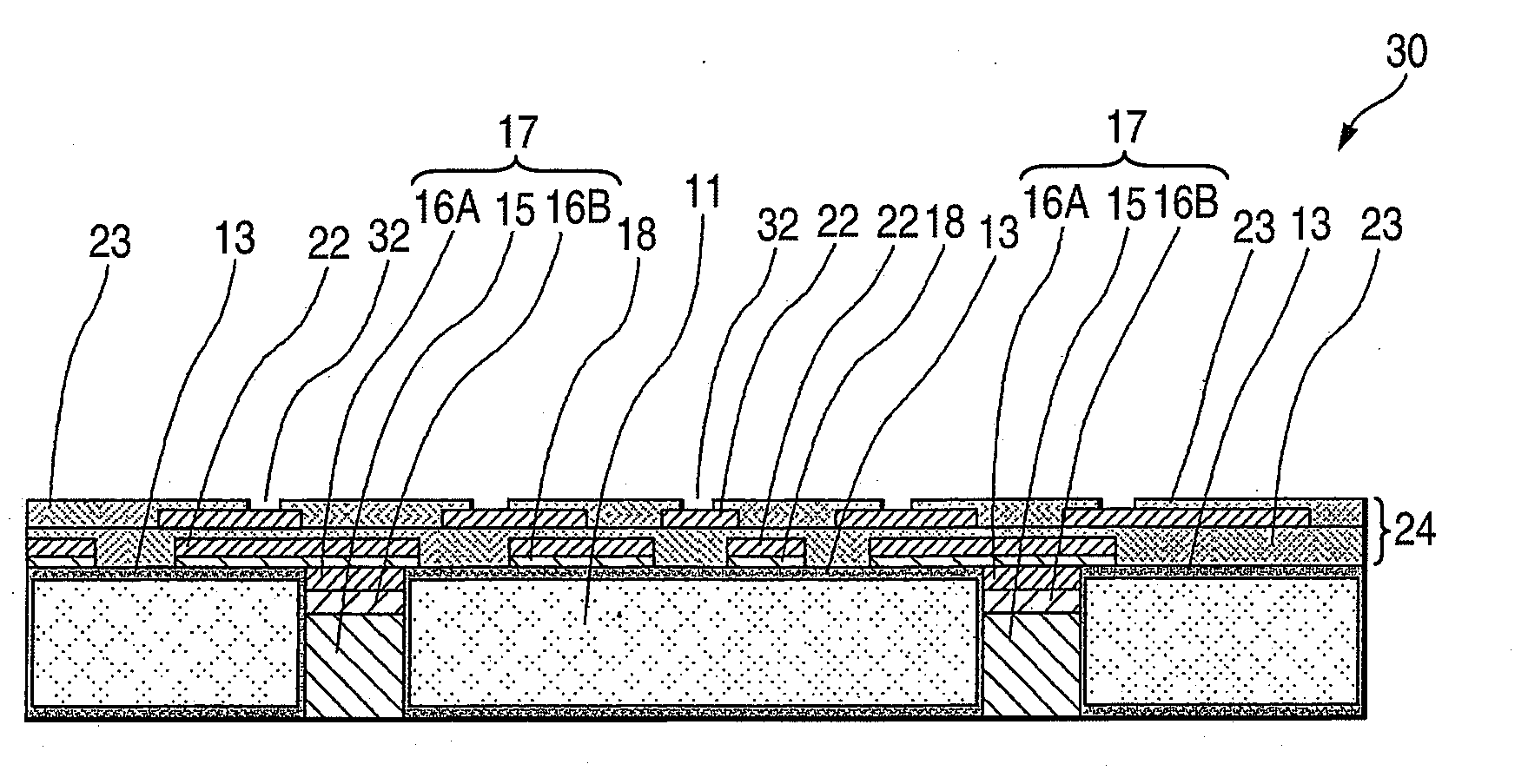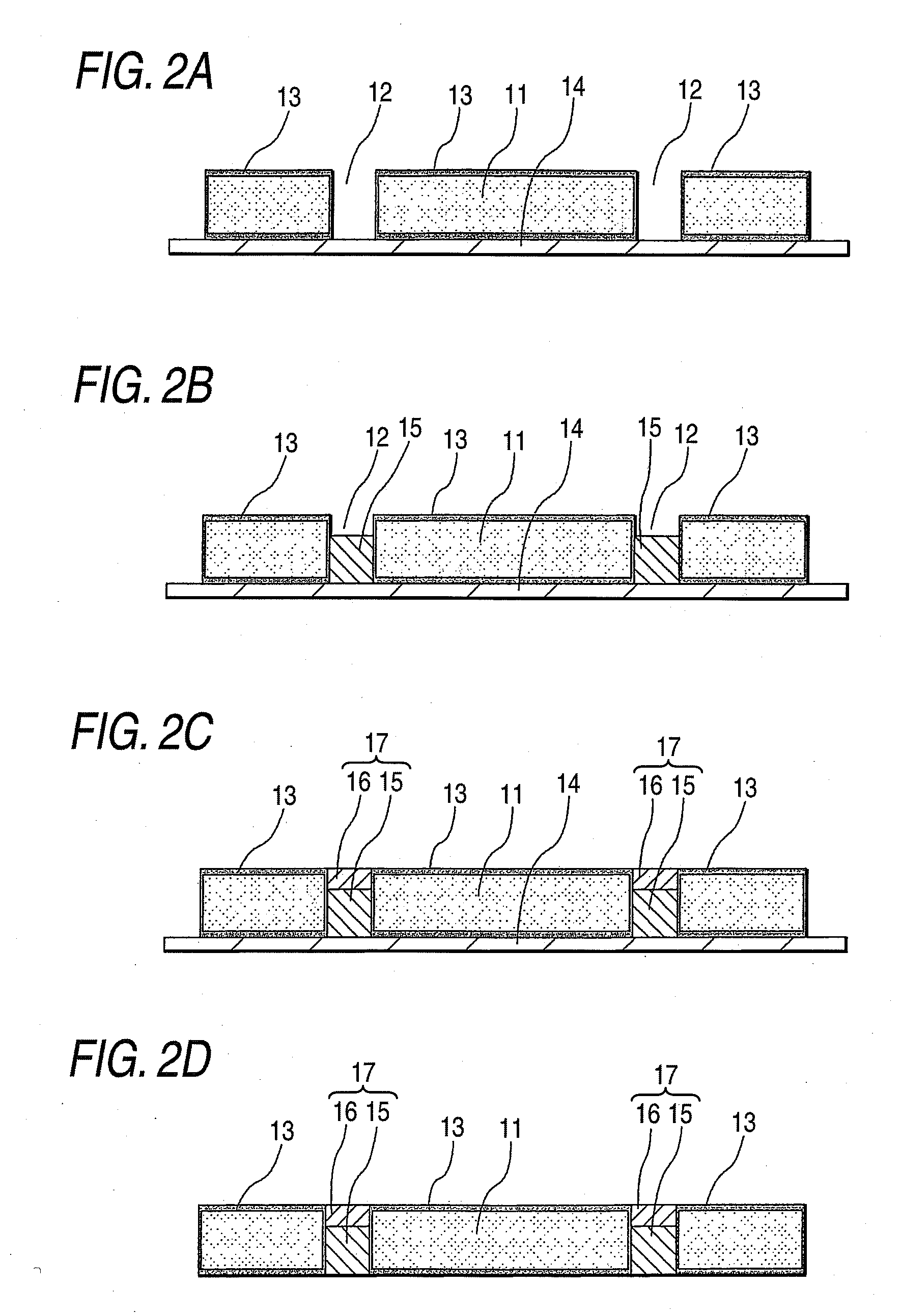Silicon interposer and semiconductor device package and semiconductor device incorporating the same
a technology of silicon interposer and semiconductor device, which is applied in the direction of semiconductor devices, semiconductor/solid-state device details, electrical apparatus, etc., can solve the problems of cracks at the connection sections between the wiring board and the semiconductor elements, damage to the semiconductor elements, and cracks at the connection sections to achieve the effect of reliable electrical connection
- Summary
- Abstract
- Description
- Claims
- Application Information
AI Technical Summary
Benefits of technology
Problems solved by technology
Method used
Image
Examples
first embodiment
[0051]An embodiment of a silicon interposer according to the present invention will be described below on the basis of the drawings. FIGS. 1A to 1D and FIGS. 5A and 5B are sectional views showing the states at the periphery of through-hole electrodes in the respective production stages of the silicon interposer according to this embodiment.
[0052]First, as shown in FIG. 1A, after a silicon wafer 10 is sliced, it is ground using a grinder or the like to a thickness of 300 μm. After the silicon wafer 10 is processed into a thin silicon wafer 11 shown in FIG. 1B, the surface of the thin silicon wafer 11 is covered with a mask having openings at regions where through holes 12 are formed, and etching is carried out, whereby the through holes 12 shown in FIG. 1C are formed. The through holes 12 according to this embodiment are formed so as to have a diameter of 60 μm. The through holes 12 are later filled with conductive materials so as to be formed into the through-hole electrodes 17 of a...
second embodiment
[0073]In the first embodiment, since the upper face side of the silicon interposer 30 in the figure is used as a face on which the semiconductor element 60 is mounted, the solder 16 serving as the buffer section for thermal stress is filled in a desired range on the copper 15 serving as the base section and filled in the through-hole electrode 17. However, the present invention is not limited to this configuration.
[0074]The present invention relates to a structure in which the buffer section for absorbing the thermal stress generated at the portion connected to the through-hole electrode 17 and having a thermal expansion coefficient significantly different from the thermal expansion coefficient of the base section (the copper 15) of the through-hole electrode 17 is provided between the base section (the copper 15) inside the through-hole electrode 17 and the connection sections of the through-hole electrode 17. Hence, even if the wiring board 40 is on the side on which the connectio...
third embodiment
[0078]FIG. 10 is a sectional view showing the structure at the periphery of the through-hole electrodes of a silicon interposer according to a third embodiment. This embodiment is characterized in that the conductive materials filled in the buffer section of the through-hole electrode 17 are formed of conductive materials 16A and 16B that are different from each other and overlaid. In the case of this structure, it is preferable that the conductive materials 16A and 16B constituting the buffer section should be overlaid such that the elastic coefficient of the buffer section lowers gradually toward the exposed face of the through-hole electrode 17.
[0079]By virtue of the adoption of the configuration of the silicon interposer 30 according to this embodiment, the gradient (the gradient of elastic coefficient) of the deformation amount in the range of the buffer section to the base section inside the through-hole electrode 17 becomes moderate, and the reliability of the through-hole el...
PUM
 Login to View More
Login to View More Abstract
Description
Claims
Application Information
 Login to View More
Login to View More - R&D
- Intellectual Property
- Life Sciences
- Materials
- Tech Scout
- Unparalleled Data Quality
- Higher Quality Content
- 60% Fewer Hallucinations
Browse by: Latest US Patents, China's latest patents, Technical Efficacy Thesaurus, Application Domain, Technology Topic, Popular Technical Reports.
© 2025 PatSnap. All rights reserved.Legal|Privacy policy|Modern Slavery Act Transparency Statement|Sitemap|About US| Contact US: help@patsnap.com



